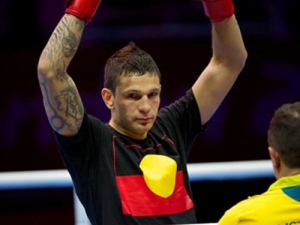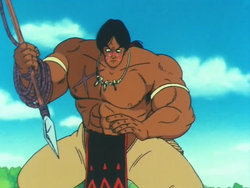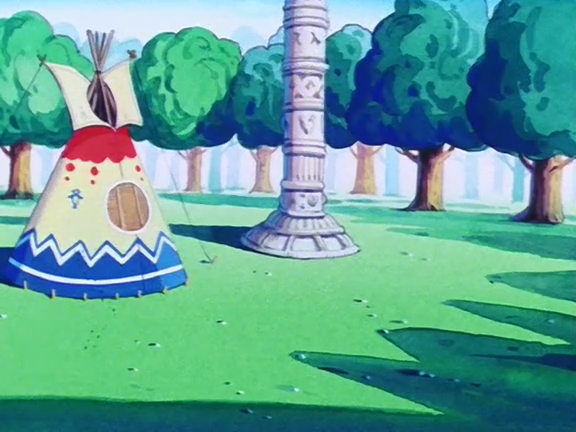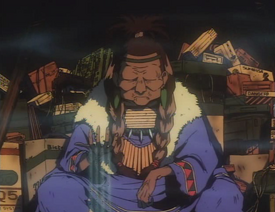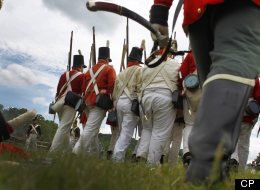In July I posted an item on a planned movie called
West of Thunder. I labeled it
Whites Star in "Thunder-Being Movie." It was mostly an excerpt from an article, but I added a few of my own comments.
Well, I got a phone call from Dan Davies, the movie's star and producer. He left a lengthy message objecting to my posting. He posted a similar message in the item's comment section.
Here's what he said:
Hey Rob,
I really enjoyed your article although you have quite a number of inaccuracies. My name is Dan Davies and I play Henry Seed.
First of all, your title "Whites star in thunder being movie" is patently wrong. Our four major actors in the film are tribal members and respected elders. You made the stereotypical assumption that unless a Native person has a name like Grey Eagle, Two Horse, White Feather, Running Cloud etc etc etc that they are not Native...as you looked up on IMDB you saw Corbin Conroy, Larry Swalley, Albert Red Bear, and Steve Garcia. They are tribal members.
You also made the assumption that I was fully white. I am a mixed race person. My great-grandfather was a Seneca of the Iroquois.
You also ripped on me as someone who hasn't done anything. I have accomplished a few things in my life. Please go to my Wikipedia page for further edification. http://en.wikipedia.org/wiki/Dan_DaviesWikipedia
I'm also attached to 6 other full-length feature films and an HBO TV project.
But enough about me...you questioned how I could become the embodiment of a Thunder Being (Wakinyan. I meant that in its literal sense... that a Wakinyan physically embodies or incorporates the body of Henry Seed...not intellectually, emotionally of fully spiritually. In my article I actually state that Henry is a "conflicted Wakinyan" he is "west of thunder" that he only brings the thunder and lightening not the rains that bring growth.
Also you state that Henry, the white guy, is the hero. That is wrong. Henry wants to bring revenge and retribution, the real heroes and victors are the Lakota elders who choose the path of forgiveness and peace. They actually make Henry see the error of his ways.
Also my film is unlike many westerns that have the Natives speaking English. We do not. We feature the Lakota language. About 1/4 of the film is in Lakota.
You also stated that we have no Native advisers. That is wrong. We had 5 Lakota elders advise. Among them Lakota educator Monica Terkildsen. Our "white" adviser was none other than Michael Blake of "Dances with Wolves" fame. also my language tutor Larry Swalley, is a fluent Lakota speaker and noted Lakota historian and storyteller. He also plays my great-great grandfather's namesake Minor Running Cloud.
You also mentioned that me playing an embodied Thunder Being might be wrong or disrespectful. According to Black Elk, one of the most respected and quoted elders, medicine men and heyokas...he believed in the interconnectedness of all the circles or "hoops" of all the races, creeds, religions. He was a fully Lakota man and a fully Roman Catholic that believed, through his 50 years of missionary and charitable works, in the melding of all mankind and mankind's beliefs.
Last but not least Rob do not judge a book, film or person by its cover. I have lived that all my life. People make the assumption that because I have blue eyes that I am fully white. But the same blood that courses through my veins courses through all of the indigenous people of North America. So sometimes you have to delve a little further for the truth. So please delve into our movie when it comes to your neck of the woods before you judge. I think you may be pleasantly surprised. Thanks Rob and take care.
Warmest regards,
Dan DaviesRob's responseHey, Dan...I got your phone message. And I see you managed to post your comments in my blog as well. Alas, your responses are the only ones with errors.
For starters, it wasn't my article. I just commented on Cheryl Anderson's article in the Wisconsin Post-Crescent.
The article says you, Michael Worth, Crispian Belfrage, Raffaello Degruttolla, and Sadie Kaye are the actors involved. It doesn't list any other major or minor actors. Which of you five are "tribal members and respected elders"?
I know all about Native names, thank you very much. I've written about the subject extensively. I also work at NativeCelebs, so I'm familiar with the top 100-200 Native actors. I've never heard of Corbin Conroy and the others who weren't mentioned in Anderson's article.
The fact that they weren't mentioned and I don't know them has nothing to do with their names. You couldn't be more wrong if you think I think Native actors must have names like Grey Eagle, Two Horse, or White Feather. I'm betting I know a lot more about the careers of
Adam Beach,
Irene Bedard,
Eric Schweig, Kimberly Guerrero, and August Schellenberg--none of whom have stereotypical names--than you do.
7/8 white = whiteYou say you're 1/8 Seneca. I presume you're not enrolled in the Seneca Nation. In my book, that makes you a white man with a small amount of Native blood. Same as
Johnny Depp,
Taylor Lautner, and every other "mixed-race" actor I've criticized over the years. I'm comfortable calling anyone who's 7/8 white "white."
And when I wrote "whites star," I was referring to the characters as well as the actors. Is your character also 1/8 Seneca? Unless he's half Native or more, I'd say
West of Thunder has a white star: Henry Seed.
Whether Seed is the hero or the protagonist, he's the main character. That means he and you are on the screen more than anyone. True or false? Answer that and then we'll discuss whether the movie is about him or the Lakota.
IMDB lists only your credit for
Ed Gein: The Musical. If the listing isn't up to date, whose fault is that? Wikipedia lists more, but I'm not seeing a lot that qualifies you to write a major motion picture about Lakota spirituality. Which was my point.
Michael Blake isn't exactly the go-to guy for Native-centric movies. His main claim to fame is
Dances with Wolves, the epitome of the "white man saves the Indians" genre. Now you're making another movie that fits into that genre. It doesn't matter if Seed learns a lesson at the end if he dominates the action.
I wrote that "As far as I can tell," no Indians are participating in the movie. I'm glad to hear some
are participating--as actors and advisers. But the error is yours for not communicating the facts to writer Anderson, or hers for not reporting what you told her. I accurately summarized what I read.
You're telling us
West of Thunder is a movie about the Lakota starring Lakota actors. Anderson made it sound like a movie about a white guy starring white actors. Did you fail to tell her everything you're telling us, or is she merely a bad reporter? Or are you spinning the movie differently for different audiences, and I caught you at it?
Black Elk speaksYou're citing Black Elk as your justification for casting a white man to play a white character who becomes a Lakota "thunder being"? For starters, Black Elk is only one Lakota. His views are 80-plus years old. He never confronted the modern problem of non-Indians appropriating the Lakota religion for their own purposes.
But if you want to cite him, okay. Let's review his position:
Black Elk (1863-1950): A Brief BiographyAccording to Vine DeLoria, there were practical reasons for the Indian conversion or pretense at conversion. Indian religion was banned on many reservations, and conversion made the whites happy and made life easier. The Indians looked at their situation and then looked at the white man's numbers and wealth. The white God seemed more powerful and better able to take care of his people (DeLoria 106-109).
Black Elk became a catechist, performing many duties such as church services, baptisms, last rites, and instruction in Catholic doctrine in the absence of a priest. According to Lucy, he traveled tirelessly and converted many Lakotas and other Indians to Catholicism. When asked by Neihardt why he converted, he said, "So my children could live in this world." This sounds like Black Elk converted for the sake of expediency.As for his book
Black Elk Speaks:
What were Black Elk's motivations for telling his story? Neihardt said that he believed Black Elk's purpose was to preserve his great vision and Lakota history for his people after he was gone. To the Native American people, ritual and ceremony are extremely important. The very telling of the stories was a kind of ritual that could restore and transmit the power of the vision and transfer some of the burden of his vision onto Neihardt (Wiget 211). Wiget goes so far as to speculate whether Black Elk used Neihardt to send his message to his people before he died (Wiget 214), and that he purposely tried to draw parallels between Lakota spirituality and Christianity to elicit sympathy and help for his people from the whites (Wiget 83).We can summarize Black Elk's goals succinctly. He was trying to preserve the traditional Lakota religion while justifying his conversion to Christianity. He was
not saying the two religions were interchangeable or white men could be part of the Lakota religion.
I'm pretty sure you won't find any quotes in Black Elk's work advocating that white men go on vision quests or participate in Sun Dances. Or take on the characteristics of "thunder beings." If you disagree, show us some quotes that relate directly to
West of Thunder. Your misinterpretation of his position--"the melding of all mankind and mankind's beliefs"--doesn't come close to the mark.
While we're at it, I'm not sure how your premise differs from a thousand other Native-themed movies. A Native ghost, spirit, demon, manitou, wendigo, or skinwalker takes over a non-Indian. He goes on a rampage, seeking revenge against those who wronged the Indians. With the help of a wise "shaman" or medicine man, the good guys finally drive the entity out. Everyone learns a lesson: It's not nice to fool with Mother Nature, always respect the dead, and make love, not war.
No "melding of religions" justifies another spirit-possession movie. So tell us how
West of Thunder doesn't fit this scenario. I'd love to hear the elements that make your movie different--the ones the original article didn't mention.
Lakota war against exploitationI'm surprised you had to go all the way back to Black Elk to find a justification for your movie. It's easy to find modern Lakota statements about non-Indians exploiting their religion. Here's a well-known one:
Declaration of War Against Exploiters of Lakota Spirituality1. We hereby and henceforth declare war against all persons who persist in exploiting, abusing and misrepresenting the sacred traditions and spiritual practices of our Lakota, Dakota and Nakota people.
2. We call upon all our Lakota, Dakota and Nakota brothers and sisters from reservations, reserves, and traditional communities in the United States and Canada to actively and vocally oppose this alarming take-over and systematic destruction of our sacred traditions.
3. We urge our people to coordinate with their tribal members living in urban areas to identify instances in which our sacred traditions are being abused, and then to resist this abuse, utilizing whatever specific tactics are necessary and sufficient--for example demonstrations, boycotts, press conferences, and acts of direct intervention.
4. We especially urge all our Lakota, Dakota, and Nakota people to take action to prevent our own people from contributing to and enabling the abuse of our sacred ceremonies and spiritual practices by outsiders; for, as we all know, there are certain ones among our own people who are prostituting our spiritual ways for their own selfish gain, with no regard for the spiritual well-being of the people as a whole.
5. We assert a posture of zero-tolerance for any "white man's shaman" who rises from within our own communities to "authorize" the expropriation of our ceremonial ways by non-Indians; all such "plastic medicine men" are enemies of the Lakota, Dakota and Nakota people.
6. We urge traditional people, tribal leaders, and governing councils of all other Indian nations, to join us in calling for an immediate end to this rampant exploitation of our respective American Indian sacred traditions by issuing statements denouncing such abuse; for it is not the Lakota, Dakota and Nakota people alone whose spiritual practices are being systematically violated by non-Indians.
7. We urge all our Indian brothers and sisters to act decisively and boldly in our present campaign to end the destruction of our sacred traditions, keeping in mind our highest duty as Indian people: to preserve the purity of our precious traditions for our future generations, so that our children and our children's children will survive and prosper in the sacred manner intended for each of our respective peoples by our Creator."War against all persons who persist in exploiting, abusing and misrepresenting the sacred traditions and spiritual practices...to preserve the purity of our precious traditions for our future generations." Hm-mm, check. I'd say several of these provisions apply to your movie's premise.
Rather than consulting with Black Elk, who's dead; Monika Terkildsen, who seems to be an environmental official; or Michael Blake, try consulting with some Lakota who are spiritual leaders. Tell them your premise in detail: a
wakinyan takes over a white man and sends him on a rampage, or whatever it is. Ask them for a response that explicitly acknowledges and approves this concept. Then I'll believe you know what you're doing.
Any questions? Better luck next time you think I made a mistake. As a general rule, you're mistaken, not me.
For more on the subject, see
The Best Indian Movies.
